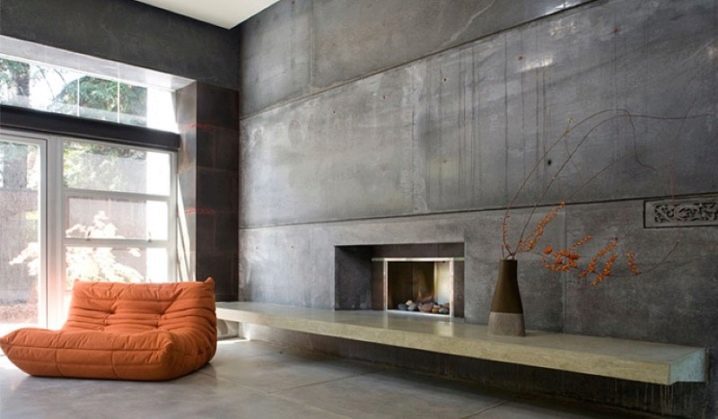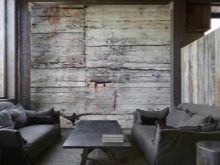Plaster for concrete in a modern interior

Concrete plaster is a rather popular and unusual option for exterior and interior decoration. This coating looks simple and stylish at the same time. Concrete plaster looks great in modern interiors, especially in interior design styles such as loft, hi-tech and minimalism.

Peculiarities
Plaster for concrete is not only an original and attractive coating, but also protects the wall from mechanical stress and wear. The concrete pavement has good technical characteristics.
The main advantages of this mixture are as follows:
- Original appearance. In addition, concrete plaster goes well with many materials (wood, natural stone, brick).
- There is a variety of textures, shades and various surface reliefs.
- There are good indicators of moisture resistance and sound insulation. The material can be used for wall decoration in rooms with high humidity levels.
- The coating creates an excellent imitation of a concrete wall. At first glance, it is difficult to determine that the surface has been plastered.
- It is permissible to use the material for interior and exterior decoration.
- After hardening, the plaster forms a high-strength coating.
- Simplicity of finishing work. To apply such plaster, no special construction skills are required.




With plaster for concrete, you can create coatings of various reliefs and textures. Also, such material can be applied in layers of different thicknesses. Due to its good plasticity and density, using concrete plaster, individual decorative elements can be created on the surface. The main disadvantage of this material is the long drying time.
Finishing with decorative plaster for concrete looks no worse than cladding with expensive materialssuch as granite or natural stone tiles. With this material, you can create the effect of an aged surface.
Decorative plaster with a concrete effect is most often characterized by its porosity. It is desirable to apply such a composition to the surface in at least two layers. By using a variety of application techniques, you can achieve interesting coating effects in different shades and textures.




Varieties
Plaster for concrete differs in composition, purpose, colors and structure.
In terms of composition, there are:
- gypsum mixtures;
- gypsum-limestone;
- sand concrete;
- warm mixtures;
- mixtures with additional special additives;
- plaster with decorative properties.






Gypsum and gypsum-lime compositions are used mainly for interior decoration before applying the finishing decorative coating. Such mixtures have a white tint, which facilitates further finishing work. The mortar is suitable for removing minor surface defects.
Sand-concrete renders help to eliminate more serious irregularities and other surface defects. Sand concrete mixtures can have different additives, which will affect the properties of the finished mortar. Conventionally, sand concrete material can be divided into three types: fine-grained, medium-grained and coarse-grained. Basically, this material is used for exterior decoration and plastering of basements.



Warm mixtures are produced in dry form, but instead of sand, they contain porous fillers.Porous components are the main components of this material and occupy most of it, which provides the plaster with good thermal insulation properties. Such material can be used for additional wall insulation.
In addition to the fact that warm mixtures can be used as insulation, this material has a decorative granular structure. Warm plaster can be applied to both internal and external walls.
The composition of one or another type of finishing material may include special additives that improve certain technical characteristics of the plaster. Such mixtures can provide a high level of sound insulation or thermal insulation.



Mixes with a decorative effect are used for finishing. Such a surface does not need to be additionally coated with a decorative layer.
According to its composition, decorative plaster is divided into two main types:
- micro-concrete based material;
- products based on microcement.

The composition of micro-concrete material includes cement, polymer additives, quartz chips and dyes. Such a solution is distinguished by good plasticity and a high level of adhesion. The coating is resistant to sudden temperature changes, high humidity and chemicals. You can use synthetic detergents to clean the surface.
Other advantages of this composition include:
- resistance to mechanical stress;
- fire resistance;
- does not absorb odors;
- wear resistance.

Micro-cement mixture is made on the basis of cement and polymers. This solution can be used both as a topcoat and as a finishing before facing with other material. The micro-cement mixture adheres to most types of surfaces and creates a good waterproof layer.
Let's consider the main advantages of this mixture:
- high density of the created coating;
- moisture resistance;
- resistance to mechanical stress.
It is desirable to apply microcement to the surface in three layers: the first layer will serve as a kind of primer; the second is a decorative coating; the outer layer is protective.
To make the coating look more attractive, the surface can be treated with a special wax or clear varnish.


Colors and designs
The decorative coating rarely completely mimics the concrete structure. Some manufacturers produce plaster mixes for concrete with certain fillers, which allows you to create interesting effects on the surface. In addition, color schemes can be added to conventional formulations in which the color range is many shades of gray.
The following types of structural concrete plaster are popular:
- Variety with a stone effect or relief of mountain ranges.
- With gilding. Requires special skills when applying, since during finishing it is necessary to manually cut a relief pattern on the surface.
- Metallic plaster. With this mixture, you can get the effect of a rusty surface.
Using stencils or a special application technique, you can create various textured and embossed coatings. The micro-concrete coating can be easily polished to a perfectly smooth state, the coating will feel like silk to the touch. Concrete plaster goes well with many materials: wood, metal, porcelain stoneware. Concrete pavement perfectly complements such modern interior styles as loft, high-tech, modern, industrial.




Application area
This material is most suitable for rooms with a large area and high ceilings. In small rooms with low ceilings, a concrete-effect coating can visually reduce the space. In a small room, it is permissible to revet one wall with this material, while creating an accent on it.
Plaster for concrete can be used to finish not only walls, but also ceilings. When lining the ceiling, it is advisable to alternate the concrete coating with other materials.At first glance, concrete surfaces appear to be rather rough. However, with the help of a concrete coating, you can create an atmosphere of comfort if you combine it with natural wood in the interior.
Concrete surfaces are perfectly combined with furniture and decorative elements of bright colors. By creating an accent on certain areas of the surface with the help of lighting fixtures, you can advantageously emphasize the texture of the concrete coating.
Microcement compounds can be applied to a wide variety of materials: metal, wood, plastic, ceramics, as well as not only vertical, but also horizontal surfaces. These properties significantly expand the scope of this mixture.


Manufacturers
Many manufacturers of finishing materials have concrete coatings in their assortment. The line of such products from different companies may differ in quality, shades and material properties.
San marco
The products of the famous Italian manufacturer San Marco are sold in Russia by the Paints of Venice company. San Marco manufactures a wide range of decorative paints and plasters for indoor and outdoor use. The materials of this company are of high quality and environmental friendliness. All products are made only from natural ingredients without the use of toxic substances.
The range of renders for concrete is also distinguished by a wide range of coatings with various effects. In addition, each separate type of product, whether it is concrete with elements of rust or with the effect of artificial aging, is available in several shades at once.



Cravel
The French company Cravel occupies a leading position in the production and sale of decorative materials all over the world. In addition to decorative coatings, the company offers a wide range of volumetric stencils to create interesting designs and patterns on the surface.
Cravel's line of plaster for concrete is called Loft-Concrete. This product is produced on a water basis. The composition is easy to apply, high quality and odorless.
Other advantages of Cravel plaster include:
- good level of sound insulation;
- high rates of thermal insulation;
- a wide range of materials in various shades and decorative effects.


Derufa
The German company Derufa produces decorative materials based on innovative technologies and proprietary developments. The assortment of the company is constantly updated with new products. This is due to the high speed of introduction of new materials.
The line of decorative coatings for concrete produced by Derufa is called Calcestruzzo. The material can be used to level walls and create minor surface reliefs.
The following advantages of the materials produced in the Calcestruzzo line can be distinguished:
- Environmental friendliness. The mixture does not contain toxic substances and solvents.
- Good level of vapor permeability.
- High ductility. The plaster does not flow when applied.


Beautiful examples of use
- Concrete plaster is well suited for loft-style studio-type apartments with high linens.
- Walls and partitions with the effect of rusty concrete in the interior, made in cold shades.
- Concrete flooring can be used for more than just rough, minimalistic styles. You can also create a cozy atmosphere with this material.



- With the help of special stencils, the concrete coating is decorated with various patterns or patterns.
- Concrete flooring in a modern interior goes well with brick-like tiles.


For even more options for plastering for concrete in the interior, see the next video.













The comment was sent successfully.